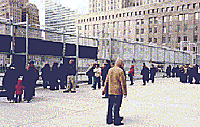 This was submitted about a year ago, but has been delayed in publication. Hence some of the references are out of date, as well as the speculation for the future of the site. However, in my editorial opinion, I felt it was worth leaving it as it was a year ago, when the wound, while clean, still rubbed raw. Any "datedness" is my responsibility, not Tony's -- DWT
This was submitted about a year ago, but has been delayed in publication. Hence some of the references are out of date, as well as the speculation for the future of the site. However, in my editorial opinion, I felt it was worth leaving it as it was a year ago, when the wound, while clean, still rubbed raw. Any "datedness" is my responsibility, not Tony's -- DWT
The military and police barricades are long gone, as is the rubble from the World Trade Center, which was carted off to the Fresh Kills Landfill on Staten Island. Most businesses in the area have reopened, and “Ground Zero,” as the WTC site is commonly known, resembles a giant construction site surrounded by a tall fence. Tourists flock to the site, along with vendors hawking everything from Fire Department t-shirts and caps to souvenir books.
On a cold Sunday afternoon in December 2002, approximately 14 months after “9/11,” I brought my camera to the Ground Zero area. In photographing the many memorials created to honor those who died, I have chosen to emphasize those which were made by small groups and individuals.
The WTC Site
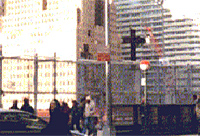 The first thing that strikes one when arriving at Ground Zero is its size. In a place as densely packed as Manhattan, where space is measured not in miles or kilometers, but in “blocks” measuring approximately 1/20th by 1/10th of a mile, it is truly huge. While constituents ranging from landlords to fire widows argue as to how best rebuild the site, work is currently underway to rehabilitate the underground transportation and other systems which were damaged or destroyed in the attack. Much of this work takes place within “The Bathtub,” as the huge concrete slurry wall which held the Center’s foundations is commonly called.
The first thing that strikes one when arriving at Ground Zero is its size. In a place as densely packed as Manhattan, where space is measured not in miles or kilometers, but in “blocks” measuring approximately 1/20th by 1/10th of a mile, it is truly huge. While constituents ranging from landlords to fire widows argue as to how best rebuild the site, work is currently underway to rehabilitate the underground transportation and other systems which were damaged or destroyed in the attack. Much of this work takes place within “The Bathtub,” as the huge concrete slurry wall which held the Center’s foundations is commonly called.
Note the cross which appears to be in the center of the site. This consists of a pair of steel beams found in the rubble, which were placed on a pedestal by construction workers as a memorial.
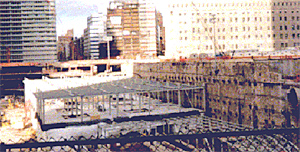 The “Bathtub”
The “Bathtub”
The photo was taken from the south end of Ground Zero, where the viewing platform set up for family members of those killed in the attack was located. Note the “Bathtub’s” depth – approximately 70 feet. For many months recovery personnel worked in the site, and each time a body was recovered an impromptu “honor guard” would line up along the sides of a ramp leading to the street level. In addition to construction laborers, hundreds of off-duty New York City Firefighters volunteered to sift through the rubble for the remains of their 343 comrades who perished at the scene. A major priority at this time is to restore service on the Port Authority Trans Hudson Railroad (PATH), whose terminus was destroyed in the attacks, along with one New York City subway station. Current plans call for a new transportation hub to link the restored PATH station with local subway lines, ferries, and a possible extension of commuter rail service to the area. At least one of the proposed designs for the new World Trade Center incorporates some of the original slurry wall as a memorial.
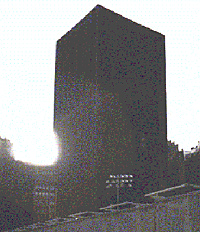 The Deutsche Bank Building
The Deutsche Bank Building
Although most of the structures in the WTC area have reopened, the Deutsche Banks' 40 floor building (right) remains unoccupied, its windows boarded over and the entire structure covered by plastic mesh. A form of toxic form of toxic black mold has contaminated the entire structure, making it unsafe for occupation.
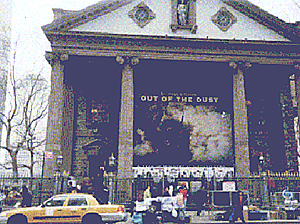 Saint Paul’s Chapel
Saint Paul’s Chapel
Built in 1766 St Paul’s is Manhattan’s only remaining pre-Revolutionary structure. George Washington had a pew here. Immediately following the attacks, the chapel was converted into a 24-hour-per-day assistance center providing food, shelter, and other hospitality for rescue, police, military and fire personnel. This side of St. Paul’s faces Broadway, one block from Ground Zero. Behind the church building stands a graveyard surrounded by a cast iron fence which borders on Church Street, across from the WTC site.
Memorials
Immediately following the attacks informal memorials started appearing on walls and fences in the WTC area. Adorned with everything from flowers and flags to t-shirts from fire departments from throughout the United States, these memorial walls became a symbol of the worldwide outpouring of grief following 9/11. Especially moving were the “Missing” posters placed by families of those whose bodies had not yet been found. Typically printed on paper, few of these remain.
Today most of the posters and banners have been dismantled, their contents having been stored for possible display at a permanent exhibit.
 At the time these photos were taken the largest remaining collection of memorials hung on the fence surrounding St Paul’s and its graveyard, but the church’s staff have been slowly removing these as well. Directly across the street from the WTC site, the sidewalks surrounding the graveyard have become a popular tourist spot. Some come to view the site and mourn. Others have their pictures taken, and many patronize the numerous vendors who have set up tables to sell everything from picture books to photographs to t-shirts. On the day I took these pictures there were about a dozen vendors’ tables alongside St. Paul’s, one of whom had a boom box blaring Whitney Houston’s rendition of “God Bless America.” As is typical with street vendors in New York, almost all of the merchants were immigrants, and practically
none were displaying the required permits. (One of these gentlemen shouted quite angrily at me in Spanish as I took my photos).
At the time these photos were taken the largest remaining collection of memorials hung on the fence surrounding St Paul’s and its graveyard, but the church’s staff have been slowly removing these as well. Directly across the street from the WTC site, the sidewalks surrounding the graveyard have become a popular tourist spot. Some come to view the site and mourn. Others have their pictures taken, and many patronize the numerous vendors who have set up tables to sell everything from picture books to photographs to t-shirts. On the day I took these pictures there were about a dozen vendors’ tables alongside St. Paul’s, one of whom had a boom box blaring Whitney Houston’s rendition of “God Bless America.” As is typical with street vendors in New York, almost all of the merchants were immigrants, and practically
none were displaying the required permits. (One of these gentlemen shouted quite angrily at me in Spanish as I took my photos).
Some may be shocked by this display of commercialism.
To such protests I can only respond that these vendors are following a long-standing New York tradition dating back to the 19th Century, when P.T. Barnum’s museum would display the clothes worn by murderers, and entrepreneurs dispensed cold beer to the crowds who would gather to watch public hangings. Such behavior is as much a part of our City’s heritage as the bravery of the FDNY. Besides, New York founded as a center for trade, and with a few exceptions, most of the millions of people who have arrived here from all over the world have sought the opportunity to make money.
The Future of Ground Zero
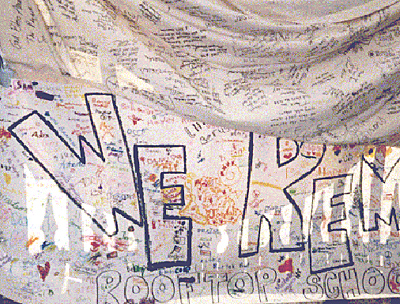 The Lower Manhattan Development Corporation (LDC) is the agency currently charged with coming up with a unified plan for the World Trade Center area – certainly not a simple task, given the often competing interests and desires of its many constituents. Recently several prominent architects unveiled their plans for the site, all of which contain a combination of retail and industrial space with a transportation center. While all plans call for a memorial, the exact nature of such will be the subject of another competition. Although some of these designs are innovative and striking, it is doubtful whether the final result will closely resemble any of them, after all the interest groups have their say.
The Lower Manhattan Development Corporation (LDC) is the agency currently charged with coming up with a unified plan for the World Trade Center area – certainly not a simple task, given the often competing interests and desires of its many constituents. Recently several prominent architects unveiled their plans for the site, all of which contain a combination of retail and industrial space with a transportation center. While all plans call for a memorial, the exact nature of such will be the subject of another competition. Although some of these designs are innovative and striking, it is doubtful whether the final result will closely resemble any of them, after all the interest groups have their say.
There is the site itself, which is owned by the Port Authority of New York and New Jersey, a quasi-public entity with the political agendas of two states. Then there is the owner, Larry Silverstein, a real estate mogul who has leased the property, and who of course wants a good return on his investment. Add to these the concerns of local politicians and business leaders, as well as the very vocal groups representing the survivors of those killed and you have an urban planning nightmare. I doubt whether anyone could come up with a design which would indeed please all who have a stake in this emotional project.
About the Author
Tony Rohling operates Historic New York Tours, which offers walking tours of the more offbeat parts of his hometown. He holds an MS in Social Work, and is studying towards an MA in Adult Education and Organizational Learning. This is his third contribution to Cry "Havoc!" Tony may be reached at tony.rohling@verizon.net.
Back to Cry Havoc! #43 Table of Contents
Back to Cry Havoc! List of Issues
Back to MagWeb Master Magazine List
© Copyright 2003 by David W. Tschanz.
This article appears in MagWeb.com (Magazine Web) on the Internet World Wide Web. Other articles from military history and related magazines are available at http://www.magweb.com